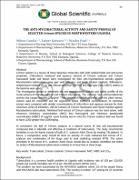| dc.contributor.author | Candia, Milton | |
| dc.contributor.author | Katuura, Esther | |
| dc.contributor.author | Waako, Paul | |
| dc.date.accessioned | 2021-07-02T09:04:39Z | |
| dc.date.available | 2021-07-02T09:04:39Z | |
| dc.date.issued | 2021-06 | |
| dc.identifier.citation | Candia, M., Katuura, E., Waako, P. (2021). The anti-mycobacterial activity and safety profile of selected Crinum species in north western Uganda. Global Scientific Journals, 9(6): 861-880. | en_US |
| dc.identifier.issn | 2320-9186 | |
| dc.identifier.uri | http://dir.muni.ac.ug/xmlui/handle/20.500.12260/407 | |
| dc.description.abstract | Crinum species is a source of many bioactive molecules with both antimicrobial and anti-tumor properties. Chloroform, methanol and aqueous extracts of Crinum scabrum and Crinum macowanii bulbs and leaves were investigated for their anti-mycobacterial activity against Mycobacteria tuberculosis using agar well diffusion, and broth dilution methods. Rifampicinstreptomycin resistant (R.S), pan African sensitive (H37Rv) and wild type (Sou 14827) strains of the bacteria were used. The investigation aimed to determine the anti-mycobacterial activity and safety profile of the crude extracts of Crinum scabrum and Crinum macowanii. The extracts had antimycobacterial activity that ranged between 1-5μg/ml. Their patterns of inhibition varied with the plant extract, solvent used for extraction and the organisms tested. Different concentrations of methanol extract were compared with similar concentrations of chloroform and aqueous extracts for their maximum zones of inhibition. All the extracts of Crinum macowanii were found inactive against Mycobacteria tuberculosis. Methanol leaf extract of Crinum scabrum was the most active, with minimum inhibitory concentration (MIC) less than1μg/ml and minimum bactericidal concentration (MBC) of 1μg/ml. acute toxicity test in mice for Crinum scabrum leaf was found to have LD50 greater than 2000mg/kg. In conclusion, the leaf of Crinum scabrum is a natural source of new anti-mycobacterial compound that is tolerable and effective in treatment of tuberculosis. The study recommends herbalists to use the leaves instead of bulb of C. scabrum Alani Davis for treating TB patients. In future, a comparative study should be done on activity of crude methanol leaf extract of C. scabrum and combination of the drugs used to treat multidrug resistant MTB. The active principles in the leaves of C. scabrum Alani Davis should also be isolated, identified and tested on strains of Mycobacteria tuberculosis resistant to at least two or three drugs. | en_US |
| dc.publisher | Global Scientific Journals | en_US |
| dc.subject | Tuberculosis | en_US |
| dc.subject | Crinum scabrum | en_US |
| dc.subject | Crinum macowanii | en_US |
| dc.title | The anti-mycobacterial activity and safety profile of selected Crinum species in north western Uganda. | en_US |
| dc.type | Article | en_US |

